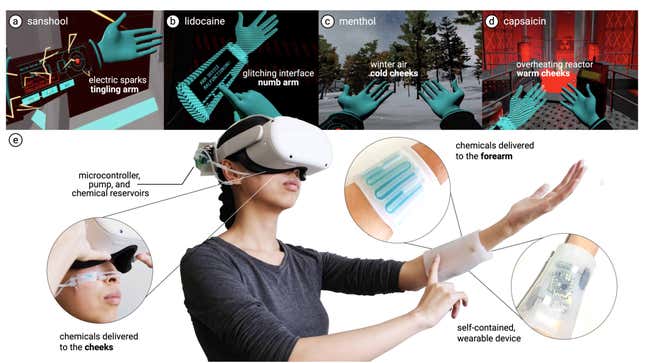
Virtual reality experiences are never going to feel like the real world until we’re able to engage all of our senses, not just vision and hearing. As a potential way to simulate a human’s ability to feel physical sensations, researchers have developed haptic VR hardware that applies chemicals to your skin to trigger responses that translate to what’s happening in a virtual world.
The goal of haptic technologies is to make a user of a device experience physical sensations that are simulated through the use of other technologies. Some of the earliest examples of this include cellphones and pagers that used spinning motors and an offset weight to generate vibrations that would grab a user’s attention without making any noise. In 1997, Nintendo was the first to bring similar technology to video games through the N64's Rumble Pak, which made the console’s controllers shake and vibrate in response to action in a game—a feature that’s now commonplace.
Haptic technology has been refined a lot since then, to the point where Apple can simulate the feel of button presses on a laptop touchpad that doesn’t actually move, but simply vibrating a VR headset or a pair of VR controllers just isn’t enough to simulate all of the sensations one can experience in the real world. So it’s time for haptics to take the next step.
Researchers from the Human Computer Integration Lab at the University of Chicago’s Computer Science Department have developed an entirely new approach called chemical haptics, which directly triggers receptors in human skin in different ways. As detailed in a recently published paper, the researchers designed and built self-contained wearables that can be worn anywhere on the human body—-arms, legs, and even the face are options—as long as it’s able to make contact with the skin.
The wearables use silicone patches and micropumps to deliver five different chemicals to the surface of the skin that produce five unique physical sensations at the point of contact. Menthol creates the sensation that the skin is being cooled, potentially simulating walking outside on a snowy day, while capsaicin, the ingredient that makes spicy foods spicy, creates a sensation of warmth, or being exposed to something that is hot.
Things get a little more extreme with the other chemicals tested. Lidocaine can create a numbing sensation, sanshool makes the skin feel like it’s tingling, and cinnamaldehyde creates a stinging sensation, and could be used as a negative form of haptic feedback in a VR game where players are tasked with keeping themselves safe but are failing to do so. All of the chemicals used are safe for humans to use, so it’s not like you’ll be sprayed with caustic acid while playing an Aliens VR simulation, but you also don’t want to spread lidocaine all over your body as that sensation (or lack of it) doesn’t wear off immediately.
Is this the future of advanced haptic feedback? Probably not exactly as is being demonstrated here, but finding ways to trigger the body’s natural receptors in new and novel ways is a definite step in the right direction toward simulating physical sensations that aren’t actually happening.